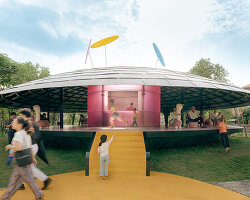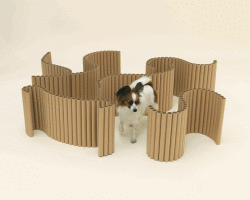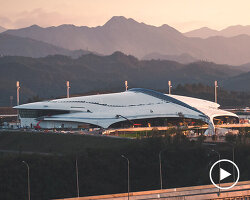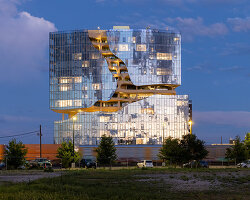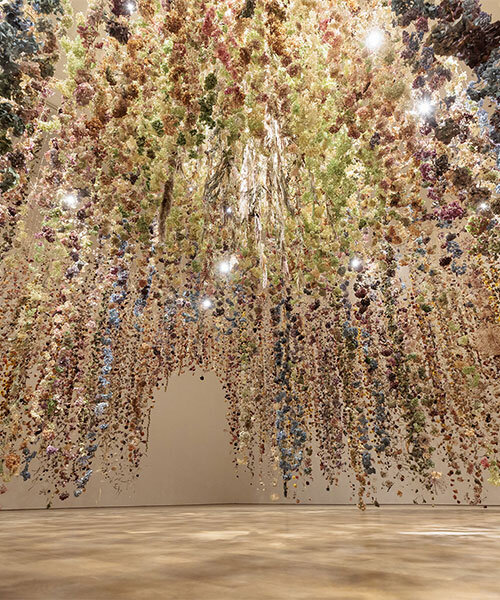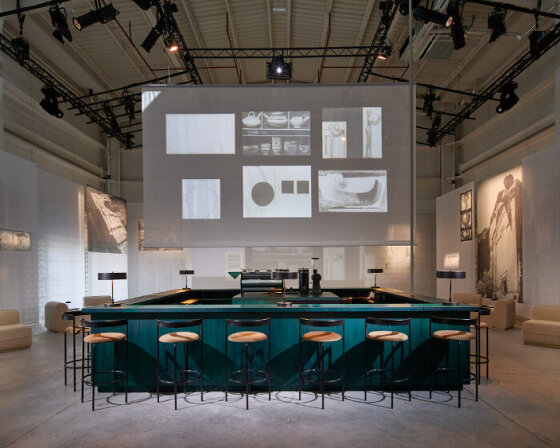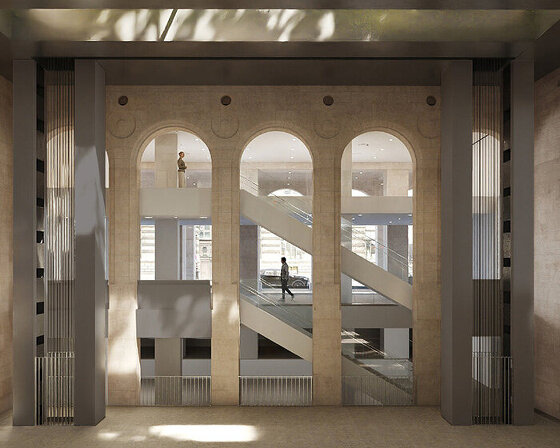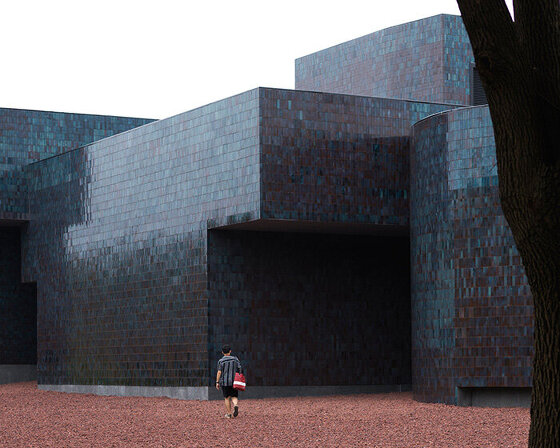ma yansong portrait © designboom
designboom met ma yansong in beijing on november 5th, 2009
what is the best moment of the day? the best moment of the day is when I get to escape from work and pick up my children from kindergarten.
and then you stop working or you have to go back? I have to come back (laughs). sometimes when I have no meetings in the office I stay at home and only when they sleep I come back.
what kind of music do you listen to at the moment? nothing special. If I’m happy I listen to the radio. 3 days ago I went to the concert hall by frank gehry and they just happened to have a classical music performance. I’m not sure if it was the space or the music but I really enjoyed myself.
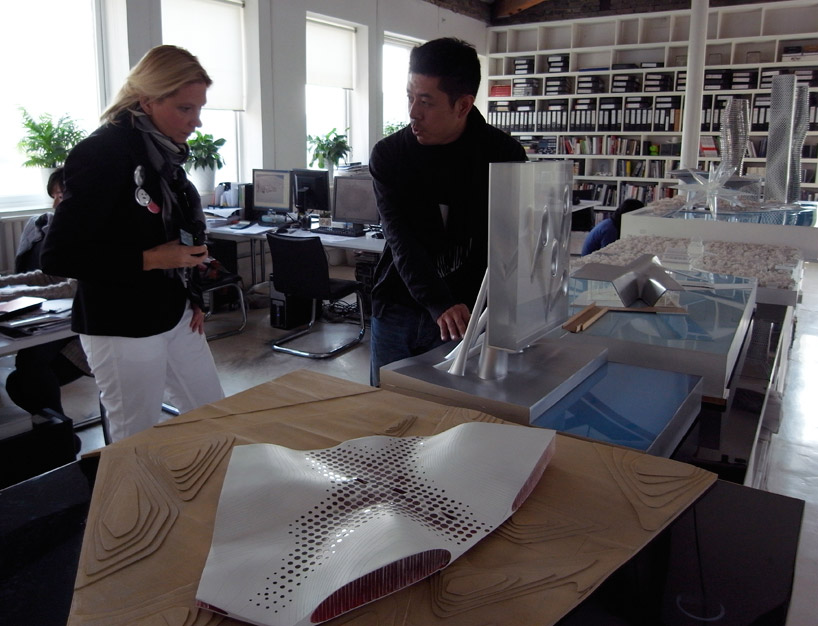 ma yansong of MAD architects shows the rostamini headquarters model todesignboom editor-in-chief birgit lohmann image © designboom
ma yansong of MAD architects shows the rostamini headquarters model todesignboom editor-in-chief birgit lohmann image © designboom
do you listen to the radio? in the car, mostly.
what books do you have on your bedside table? I don’t buy books, but a lot of people send me books, so it depends on what books they send to me.
do you read design / architecture / fashion magazines? I only read the magazines with our work in them. again, because that’s what they send to us and this is already much to read, but I flip through many architectural and design magazines regularily. I also like fashion magazines and some graphic books.
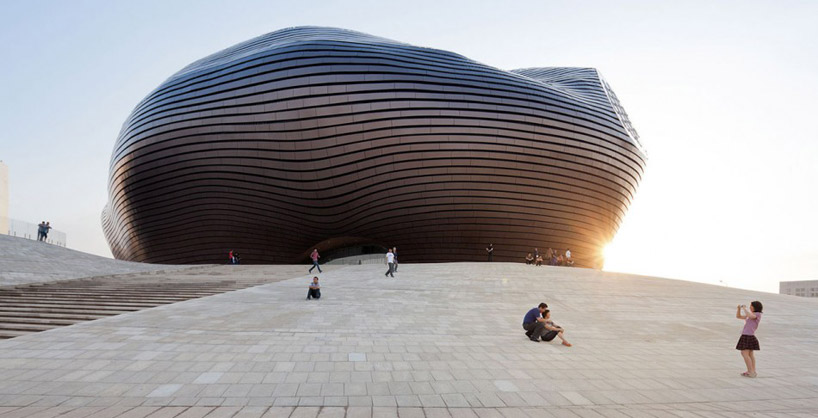 ordos museum, china, image courtesy MAD architects
ordos museum, china, image courtesy MAD architects
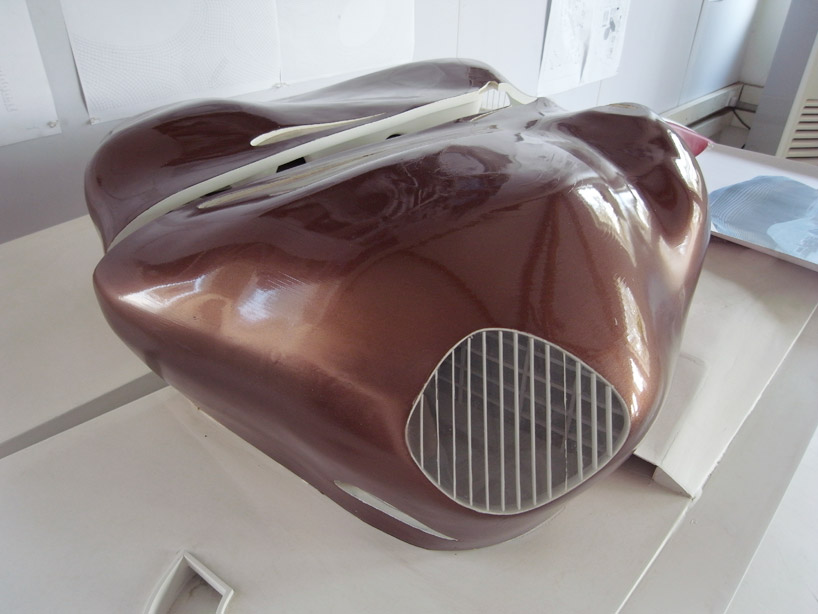 erdos museum, model, erdos, china, under construction image © designboom see more images of this project here
erdos museum, model, erdos, china, under construction image © designboom see more images of this project here
where do you get news from? the internet
I assume you notice how women dress.do you have any preferences? I like a women who dresses very clean and simple but also manages to have a good contrast of colour to make her look very cool.
what kind of clothes do you avoid wearing? usually I avoid wearing colourful clothing, but this depends on my mood. when I’m depressed I wear the same clothes 4 or 5 times. in these moments I really don’t care and I don’t want people to look at me, but sometimes when I’m with my kids and their friends my mood changes completely and I wear something casual and very colorful – but that does not happen alot to me. on the other hand being a young architect and when giving presentations I also need to look ‘cool’ or wear something formal, such as a ‘professional black suit’.
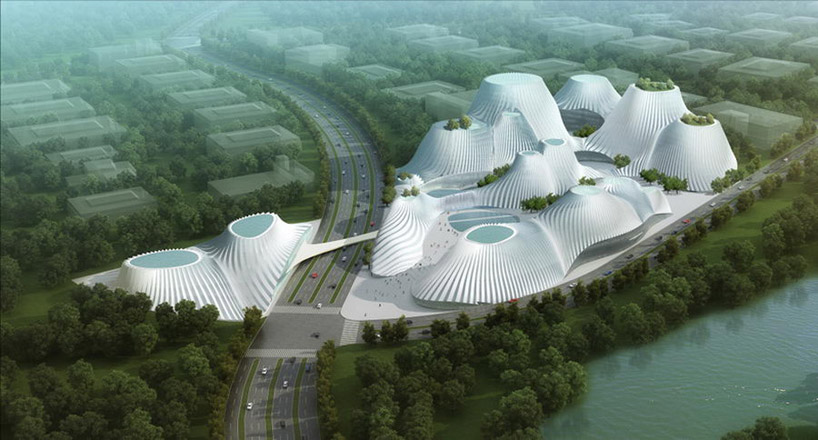 taichung convention center, china, 2009 image courtesy MAD architects see more of this project here
taichung convention center, china, 2009 image courtesy MAD architects see more of this project here
do you have any pets? no. actually when I was in middle school I use to have a dog and then I lost it. the story was that I used to ride my bike to school everyday for 40 to 50 minutes and one day along my route I found a dog and took it with me and stored it under my desk. I continued doing this for the next 3 or 4 days until my teacher’s told me I wasn’t allowed. so during class I left it in the playground but by the end of the day it was gone, so that is my short pet experience.
when you were a child, did you wantto become an architect?
no. I wanted to draw, be a professional painter. I applied to art school and they didn’t let me in (laughs). the lecturers there suggested to me to study architecture, as they said my fine art level was low. for architecture it’s probably OK (laughs).
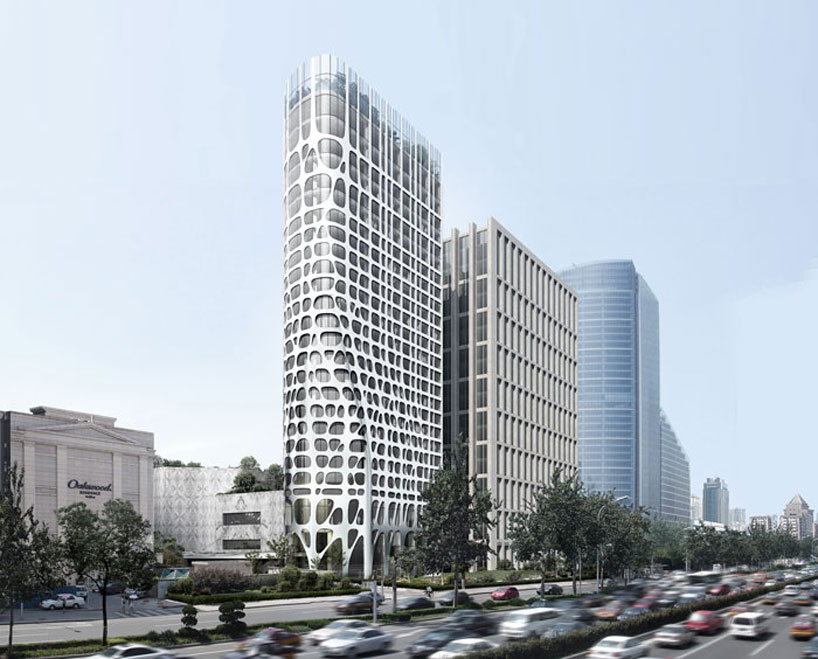 conrad hotel, beijing, china, 2009, under constructionimage courtesy MAD architects
conrad hotel, beijing, china, 2009, under constructionimage courtesy MAD architects
where do you work on your projects?my initial ideas come mostly from travel. I can not stay all day in the office, I want to continually go out, but most of the time I need to stay in the office have meetings with the various design teams.
what project has given you the most satisfaction?we did about 100 competitions in the first two years when we started the firm. we didn’t have time to organizeuntil recently when we did the archive and publishing work.I like all these proposals somehow and I feel that they all became important to me, because if it wasn’t for the first one I could never have progressed to the next project. all these buildings, visions are a very honest body of work with lots of potential.
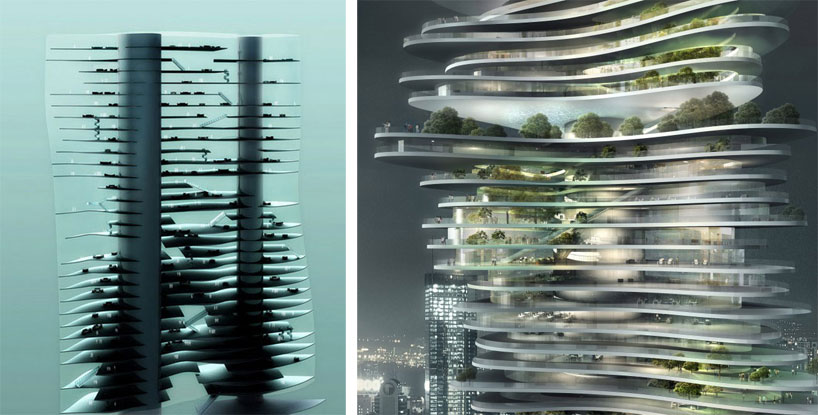 huaxi city centre, model, china, 2008image courtesy MAD architectssee more of this project here
huaxi city centre, model, china, 2008image courtesy MAD architectssee more of this project here
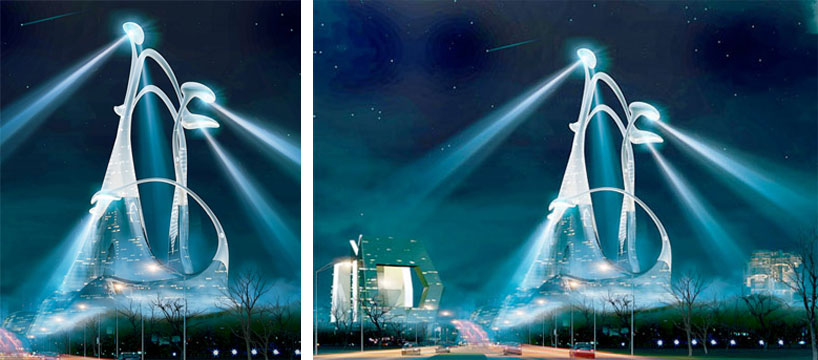 urban plan proposal for ansan city, korea, 2008 image courtesy MAD architectssee more of this project here
urban plan proposal for ansan city, korea, 2008 image courtesy MAD architectssee more of this project here
a major project that helped the office to grow?in the beginning I think we did too many competitions and we only won one, however this is the one that madeus famous. it was an international competition outside china, but made us recognized in china. this was the absolute towers in toronto, canada. they bear the name of the property but they are also called ‘marilyn monroe’, because of the curves of the towers. this was in 2006, its already half way done.
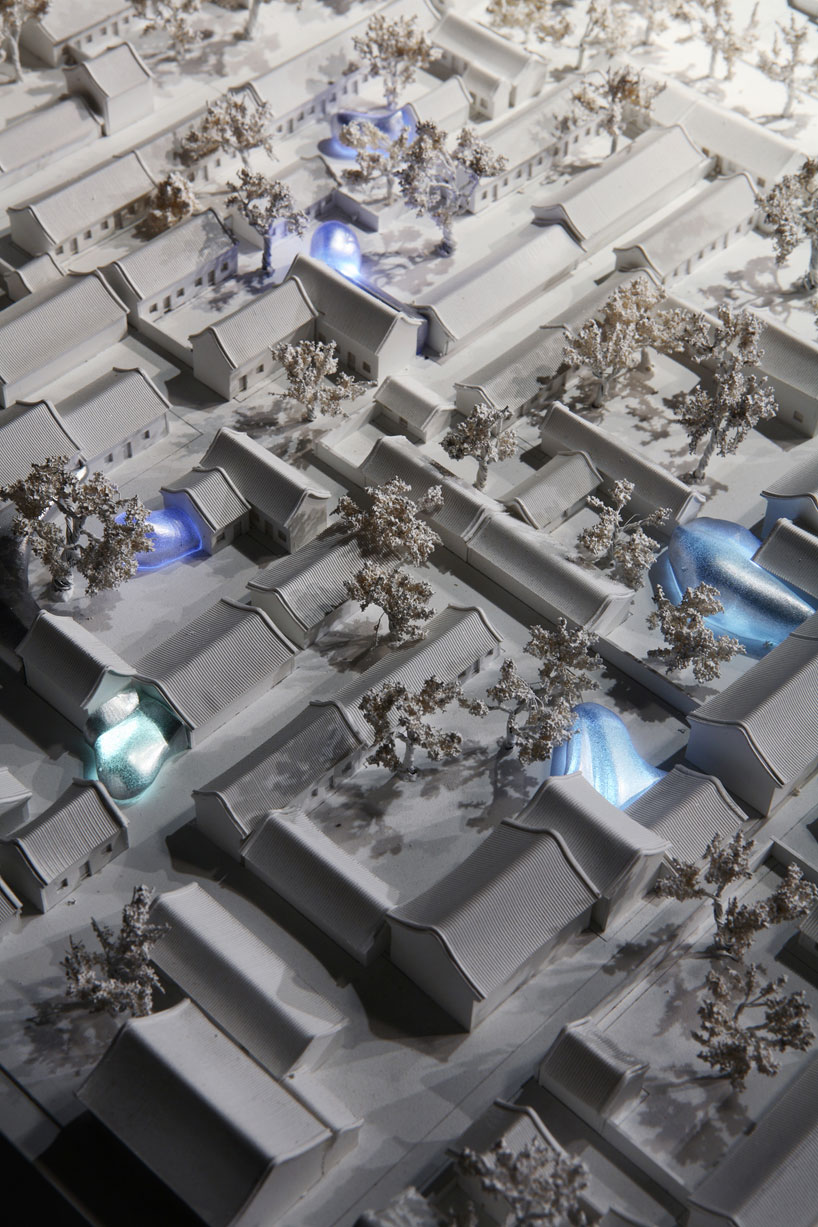 ‘hutong bubble 32’, model, completed, beijing, china, 2008 image courtesy MAD architectssee more of this project here
‘hutong bubble 32’, model, completed, beijing, china, 2008 image courtesy MAD architectssee more of this project here
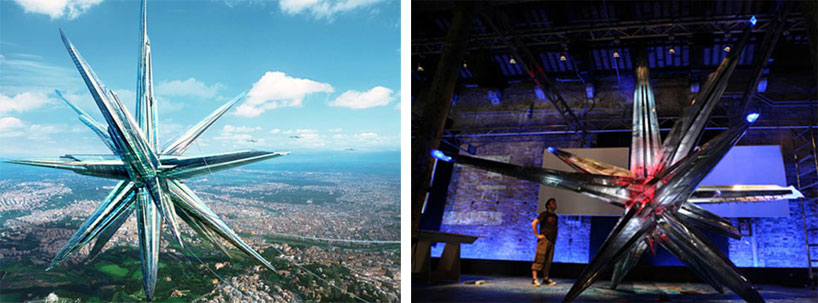 ‘superstar’, self-sustaining city, 2008, and its model, self-sustaining city at venice architecture biennale 2008image courtesy MAD architects
‘superstar’, self-sustaining city, 2008, and its model, self-sustaining city at venice architecture biennale 2008image courtesy MAD architects
describe your style like a good friend of yours would describe it.last night I was thinking something (lol) –the ‘chinese dream’ needs to be redefined with more attention to the ‘personal dream’ of our people. a dream where there are no political boundaries, which then becomes the dream for human beings. that’s what interests me a lot. I always try to do something which is open and free (perhaps involving nature).there are those architects who are realistic architectsor those utopian architects. we are part of the first, we try to plan something which is quiet real, something you can visualize.
do you discuss your work with other architects?yes. with young architects like bjarke ingels from BIG in denmark and also michel rojkind from rojkind arquitectos in mexico. those guys, like me, always travel around and it happens that we sometimes meet and present our work to each other. however we don’t meet that often. when I feel a bit lost in the office, I call up my friends and ask for advice. one time I invited the young architects tom wiscombe and elena manferdini from LA (who are also teachers) and asked them to critique our work. to them we gave a presentation for each of our projects. I think that discussing your work is very helpful, as sometimes I feel there are too many things going on.
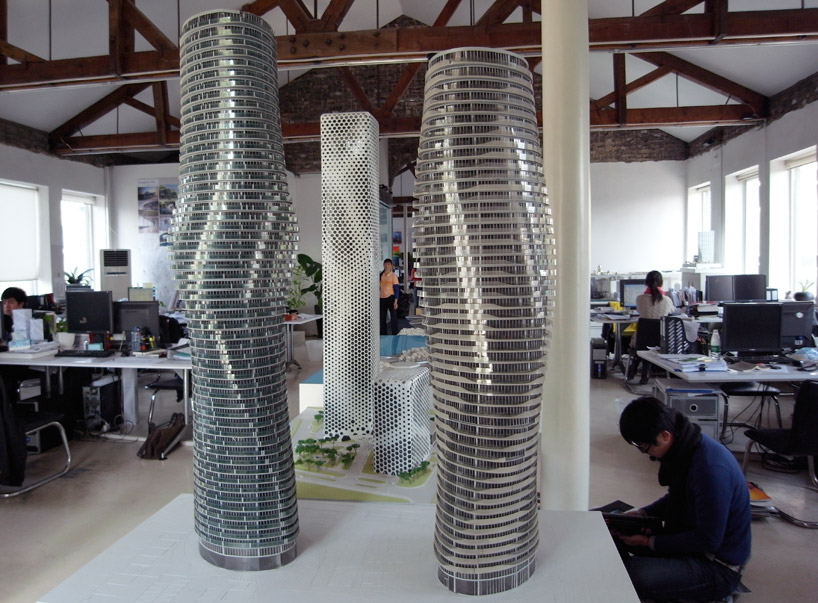 models of the ‘absolute towers’ and ‘sinosteel int plaza’image © designboom.com
models of the ‘absolute towers’ and ‘sinosteel int plaza’image © designboom.com
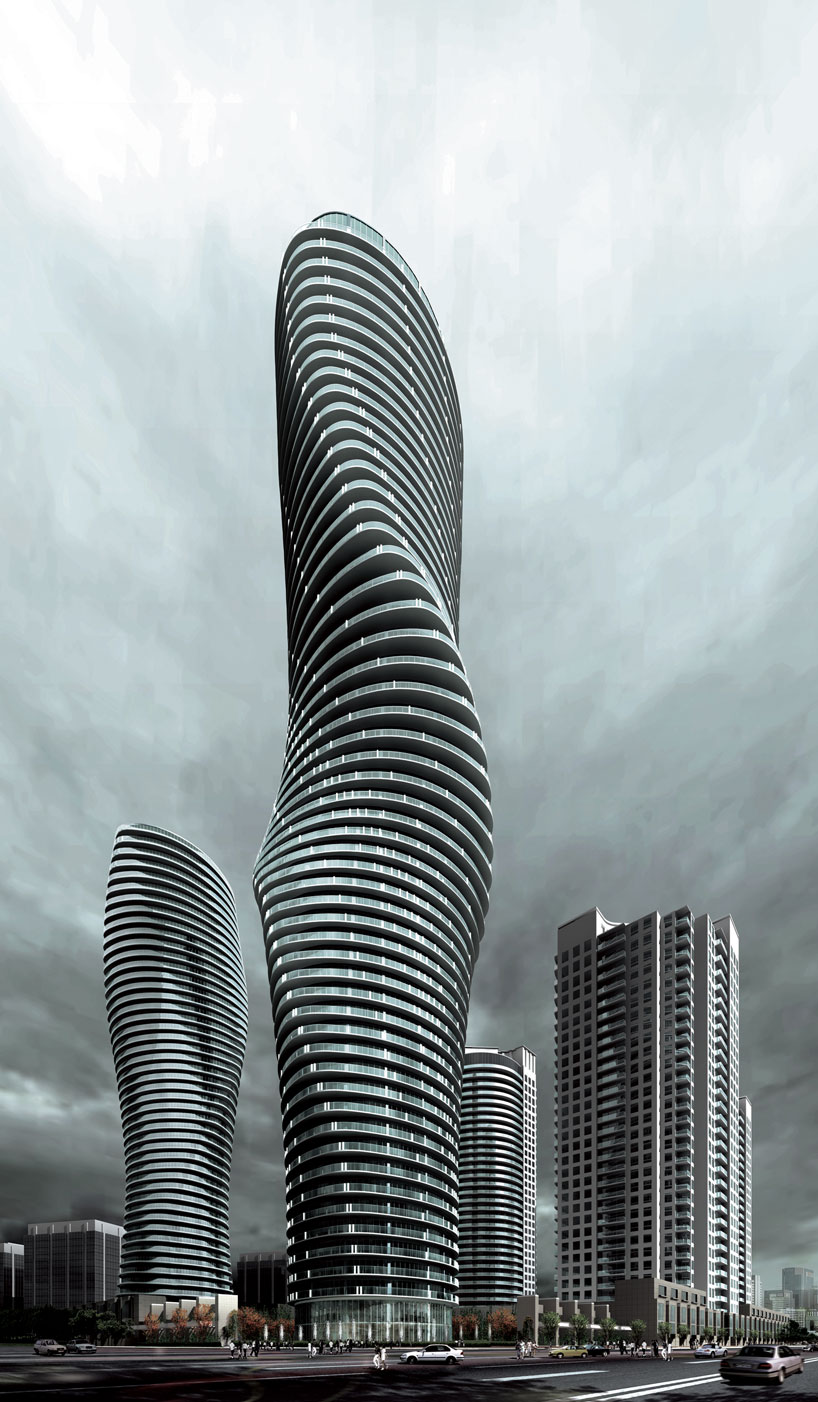 absolute towers, mississauga, canada, under construction, 2006 image courtesy MAD architects
absolute towers, mississauga, canada, under construction, 2006 image courtesy MAD architects
who would you like to design something for?I want to design a home for myself and for my family.my parents stay with us as well. sometimes when a family approaches us to design a house I try to avoid it because all families have different opinions and I don’t know how to work with them, but for my own family I feel it would be interesting. I would listen to everyone’s opinion and try very hard to satisfy all. basically this house can change when people grow. firstly it would have to be in a forest , in the middle of nature – that’s impossible in china (laughs). it would also consist of a lot of courtyards with outdoor space. something similar to the traditional buildings we had in china once. another project I would like to do is a reading room for myself. last month we went to a very special site, with a beautiful lake. you can’t really build a house there, but perhaps build a temporary structure. I imagine a small wooden container of maybe 2 square meters only, where I can admire nature, whilst reading (laughs).
you envision a city of the future?we did one project called the beijing 2050, in that vision we created a green square. where once the whole area was covered in concrete but now will be covered with trees. there’s no design, no actual shape and no architecture. its only covered with trees. I feel that the trees don’t only mean ‘green’, it is also the idea of transforming this ‘political space’ into a more ‘human space’. we also proposed a floating city in a high density situation in china, because the country’s population will continue to rise in the future. the situation is very special here, in china, compared to the rest of the world.china has a very powerful ambition. the ‘chinese dream’ now is different from what china dreamed in history. who knows what’s next ? what we might need to build high up in the sky? the project also involved preserving the old city by inserting bubbles around it. right now we are talking with some producers to see if we can make a few models and do a movie about the project, so it would be a tool to look back in history and compare how the world actually turned out to be.
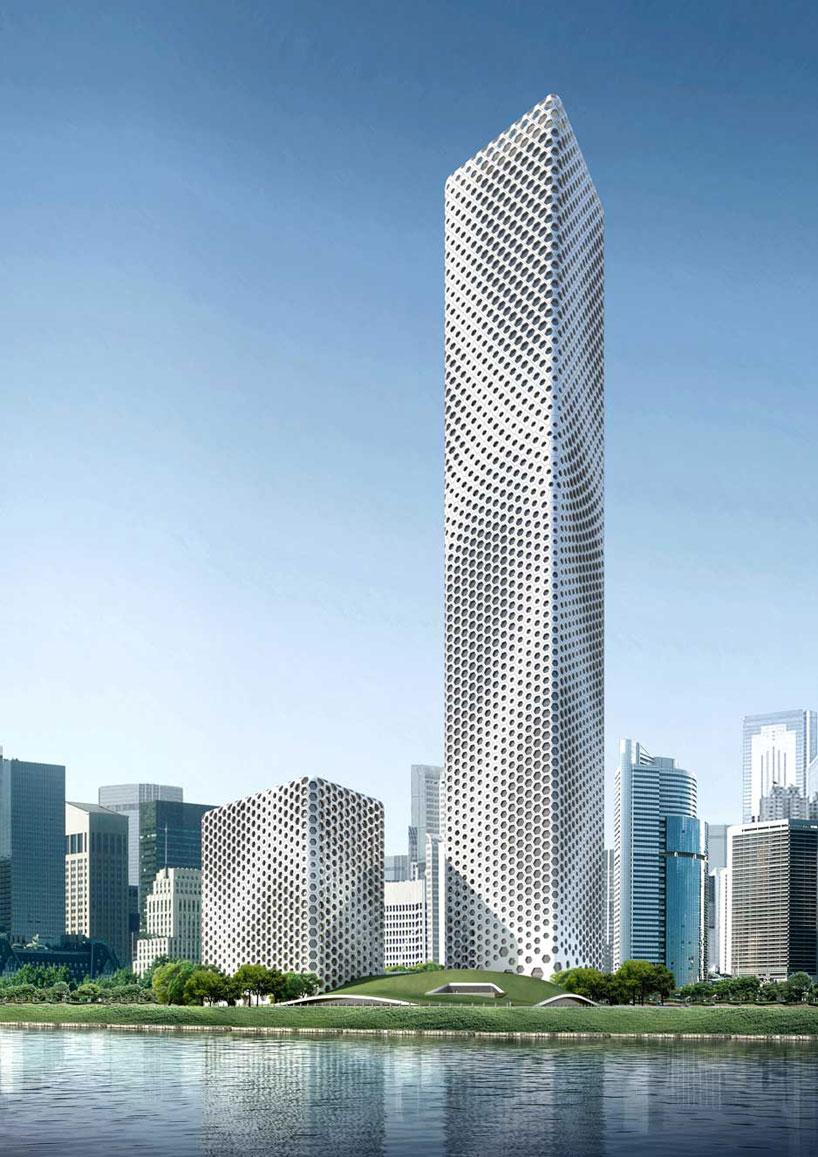 ‘sinosteel ‘nternational plaza’, day view, tianjin, china, 2006, under construction image courtesy MAD architectssee more of this project here
‘sinosteel ‘nternational plaza’, day view, tianjin, china, 2006, under construction image courtesy MAD architectssee more of this project here
is there any designer and/or architect from the past, you appreciate a lot?I like mies van der rohe because his work is oppositeto what other people did at that time.
and those still working / contemporary?zaha hadid, who was also my teacher (she’s not a good boss but was a very good teacher). she’s the first person that gave me a lot of contemporary art books (in architecture school) and gave me good advice.I like frank gehry’s work, in the beginning he did very commercial projects and then one day he changed –that’s very brave. in my work I try to link with his work.… and toyo ito. he has given a great contribution to the architectural world. he encourages a lot of people and is a sort of tutor for many young architects. I hope I can do this type of thing when I’m older.
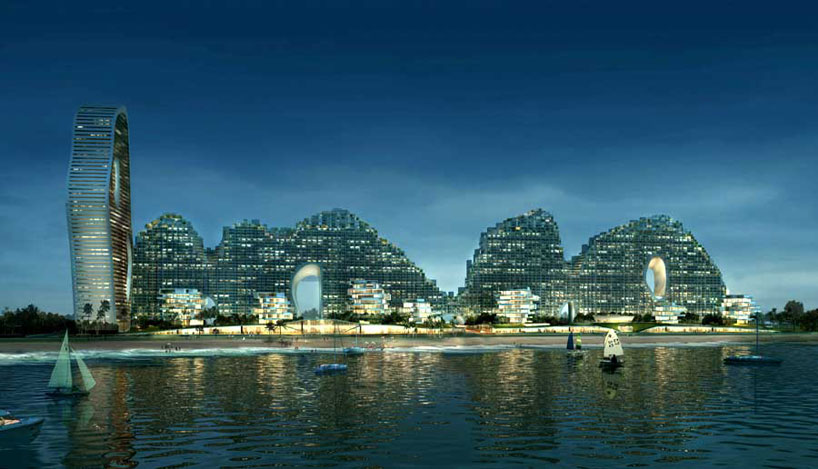 ‘fake hills’, night view, beihai, china, 2007, under constructionimage courtesy MAD architects
‘fake hills’, night view, beihai, china, 2007, under constructionimage courtesy MAD architects
please describe an evolution in your work, from your first projects to the present day.I think I’m still trying to find my way. I have so many different interests…for example, I think that it is amazing that we can do this floating island project. that was in its original version a student work of mine. at that time I didn’t know anything and I was totally not realistic. the first ideawas not so much the form itself. you know, you have this idea in your heart and soul and you want to expose it to the world by using all your energy…usually when you’re young you have great imagination but cannot do anything with it. the pity of the architecture industry is that it is full of old people. when they are given the chance to do a ‘significant something’ they might not remember what they wanted to do when they were young. I think successful architects should do something very original and not take away from that.
don’t you suffer a work overload?last month toyo ito came to my office and we talked about cultural issues within the practice. I asked him what I should do: ‘there are so many big projects coming in, if I do all of these I might lose control and maybe in 10 years time I will have 20 similar shaped buildings’. I can choose to ignore all of this and do my own thing. I don’t design all these high-rises, but only nice small buildings, but that’s not reality.I cannot ignore where I am.his answer was quiet encouraging, he said he always dreamt of having this opportunity, but it never happened to him at such a young age. and that building high-density projects is something architects should continue to do until they die. in the end I realized it was a silly question (… because that is why I am living and working in china).
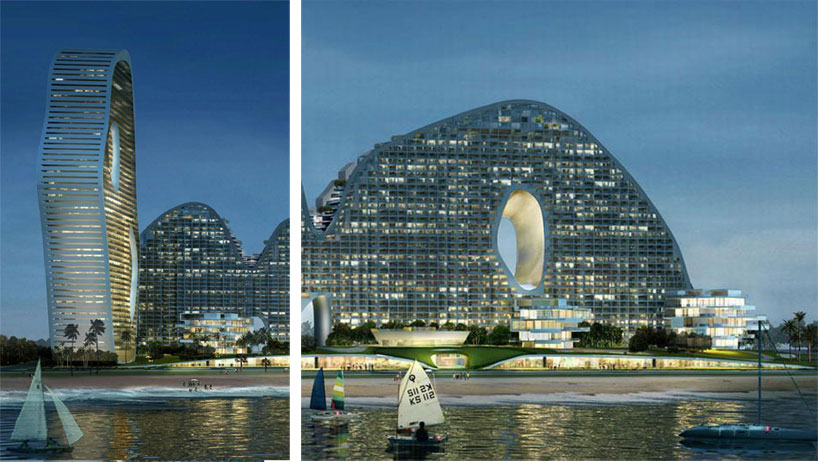 ‘fake hills’, night view, beihai, china, 2007, under constructionimage courtesy MAD architects
‘fake hills’, night view, beihai, china, 2007, under constructionimage courtesy MAD architects
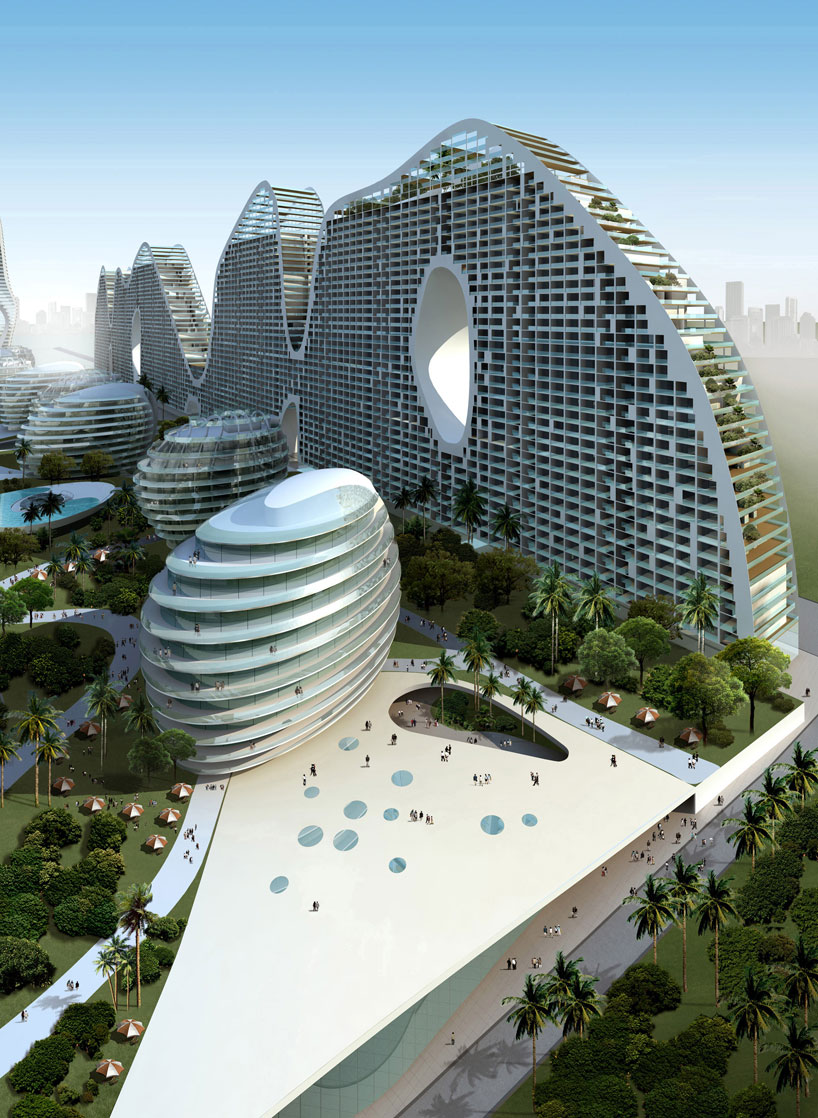 ‘fake hills’, night view, beihai, china, 2007, under constructionimage courtesy MAD architects
‘fake hills’, night view, beihai, china, 2007, under constructionimage courtesy MAD architects
what advice would you give to the young? don’t hesitate. make a decision fast. follow the first 5 seconds instinct. if you think you need to compare and you hesitate, then it must be a wrong decision. as in your life one decision comes after the other and if you realize you do something wrong, you know it is because of a previous decision, which was a mistake. I think everyone should follow their heart. robert stern, the dean of the arts andarchitecture at yale says this to all the students on their graduation day : ‘you should forget everything you learnt from school and start on your own. no matter who said what, you should believe only in yourself’.
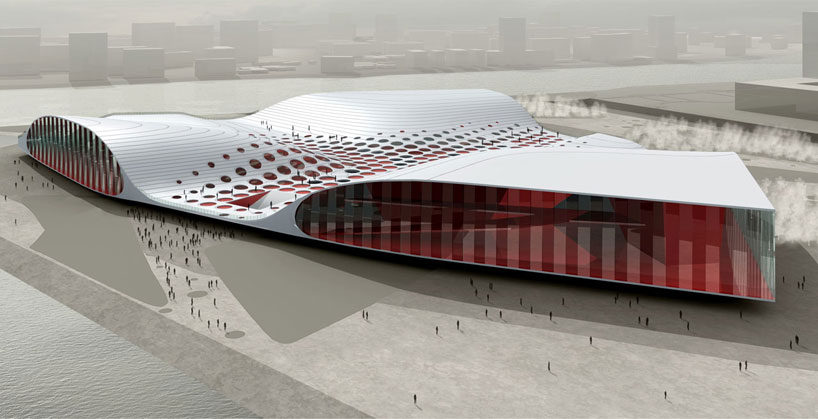 ‘changsha culture park’, changsha, china, 2005 image courtesy MAD architects
‘changsha culture park’, changsha, china, 2005 image courtesy MAD architects
what type of work experience is required?as a young designer it is very difficult to handle complexity.after school I think you should work for somebody to gainexperience – for maybe five, max. ten years before starting your own business.actually for us it was different, we just started straight away, apart from the time I worked with zaha hadid. it was only for one year, but at her office there were a lot of projects going on, at the same time, and we apprentices had to learn very fast.
are you currently teaching?no, I was teaching for two semesters, but my schedule became too hectic.
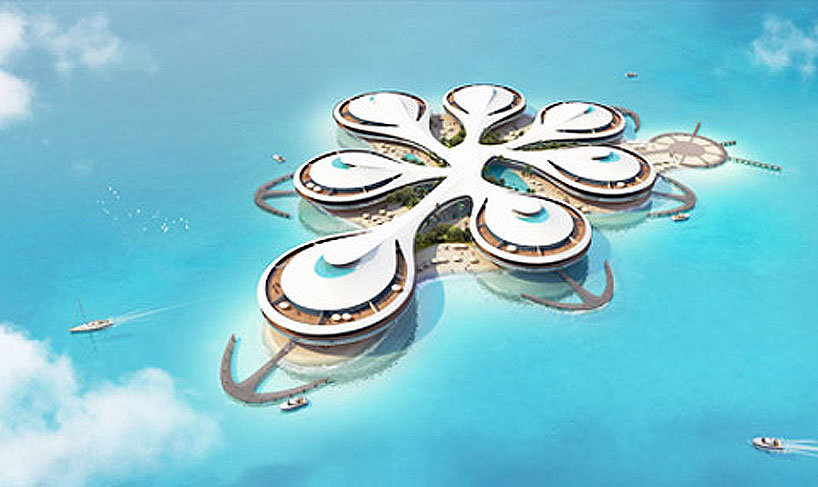 ‘tokyo island, the WORLD’ hotel, dubai, UAE, 2007image courtesy MAD architects
‘tokyo island, the WORLD’ hotel, dubai, UAE, 2007image courtesy MAD architects
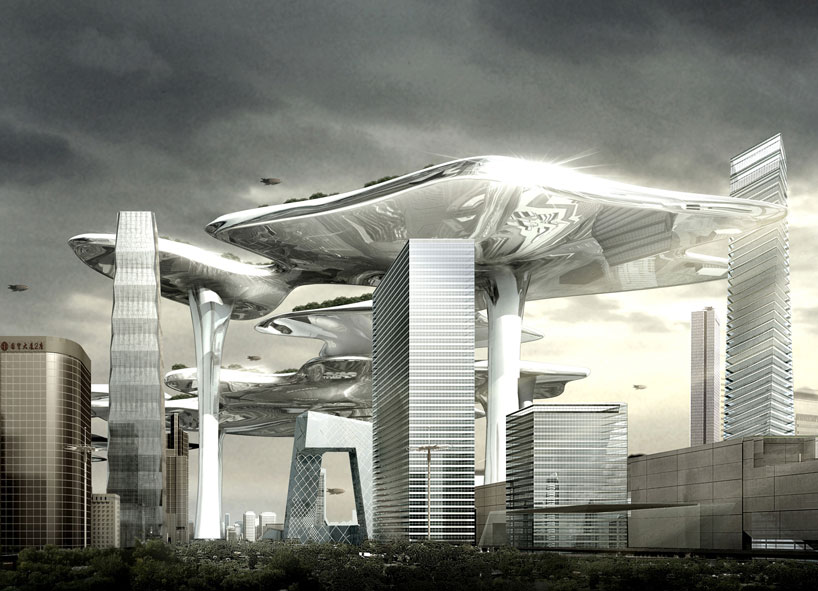 ‘beijing 2050’, plan proposal for beijing, china, 2006image courtesy MAD architects
‘beijing 2050’, plan proposal for beijing, china, 2006image courtesy MAD architects
what are you afraid of regarding the future?I hope I’m never unemployed (laughs) and as we did this project for 2050, by that time I hope I’m still alive. I think the architect’s nature is not to fear. I’m totally expecting to see what happens. if something happens or you’re not comfortable with it you can change it or at least try to change it. I think it is very simple: as an architect your job is solving problems! if the world were perfect, there would be no job for you. that’s why I came back to china, there are many things to do.


